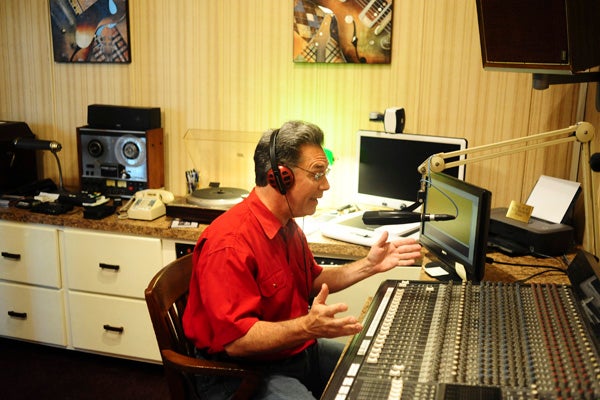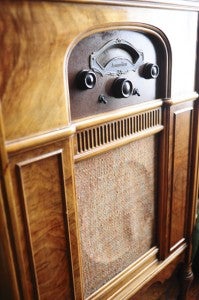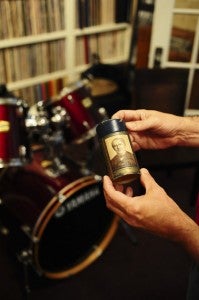
By Scott Mims
There is a place in Chilton County where the Big Band sound of the 1920s, ’30s and ’40s is still very much alive and swingin’—the Clanton home of disc jockey Scott Michaels, known to family and friends as Mike Schiermann.
Schiermann is the host of local radio show, “In the Mood,” which airs on 98.3 WSMX-LP, the campus radio station of Clanton’s LeCroy Career/Technical Center, Sundays from 3-5 p.m.
He is also an avid collector of antique radios and records of the era, and is a jazz guitarist and former member of barbershop quartet Loose Change.
Like his radio show, which shares its title with a 1940 Glenn Miller No. 1 hit, Schiermann has devoted much of his life to preserving the sounds of the past—in this case the dance music of the pre-rock ‘n’ roll era.

“Welcome to 1920,” Schiermann says as he welcomes you into his home.
Immediately you notice a 1928 RCA Victor radio, which Schiermann bought in the late ’80s. Unlike the compact radios of today, this set is an actual piece of furniture that sits on the floor.
“I bought this set from a little old lady in Homewood. She had bought it brand new. It had sat in her living room since 1928,” he said.
The ’28 RCA Victor is significant because it was the first to feature a General Electric turntable and electric phonograph pickup. Before 1925, there was no electricity involved in recording or playing records.
“Everything was acoustic before that,” Schiermann said.
An equally interesting story lies behind each of his radios, and there is one in virtually every nook and cranny of his home.
A pair displayed in a bedroom are a tribute to Schiermann’s mother—a 1937 Philco, made the year she was born, and a 1954 RCA Victor she received for her 16th birthday. The latter, which plays 45 Rpm records, can be seen in the background of a picture taken of Schiermann riding a hobby horse as a kid.
In the same room sits a 1938 Zenith he bought at a garage sale in Iowa for $20. The set needed only an antenna to work properly.
“All these radios play, and if they don’t play I make them play. If they don’t look pretty I make them look pretty,” he said.
Schiermann turned on the Zenith and tuned it to 730 on the AM dial, the frequency of his WKCJ (“We Keep Clanton Jumpin’”) broadcast from his home studio. The station reaches about one city block but is plenty strong to reach any radio in Schiermann’s home.
Within seconds, the sounds of Benny Goodman filled the room, with a surprising amount of bass.
“It plays like the Dickens,” he said. “The longer they play, the warmer they sound…it’s worth the wait.”
Schiermann described Benny Goodman’s sound as swingin’ like crazy, “But they’re kinda stiff…I found out why. It’s because they were recording at 8 o’clock in the morning!”
The band, he said, would have likely played all night long. But early in the morning is when RCA Victor wanted to record.
It doesn’t take long to realize Schiermann’s passion for the music and the machines that play it. The amount of care taken to bring out the fine inlay of a 1941 Philco can attest to that. A set like this one can be seen in Sam Spade’s office in the movie “The Maltese Falcon.”
Other models include a 1926 Grenada, an old radio from the Tutwiler Hotel in Birmingham, and the most valuable set in Schiermann’s collection—a World War II era Sparton 1-volt radio.
“What’s valuable about it is the cabinet. It’s made out of milk. I have no idea how they did it,” Schiermann said.
Yet another treasure is a 1930 Atwater Kent his great-grandfather bought for $119 on the floor of Montgomery-Ward in Lincoln, Neb.
“That was a fortune in 1930,” he said. “Luckily, my great-grandfather had a good job with the railroad company.”

Collecting is a lifelong pursuit for Schiermann, and he also collects records. He has 8,000 records organized in alphabetical order, starting with pre-1925 records and covering the genres of big band, swing, jazz, barbershop, Christmas music and rock ‘n’ roll.
Among the most unique are Durium coated paper records from 1930-1932. These singles, dubbed “Hits of the Week,” sold for 15 cents at newsstands and play the foxtrot, waltz, two-step and one-step.
“This is the sound of the past—this is dance music of the pre-rock ‘n’ roll era,” Schiermann said.
Even his turntable is a 1935 piece of equipment he purchased for $10 from a TV engineer in Sioux City, Iowa, where Schiermann grew up.
An older player can play Blue Amberol records, which are cylindrical recordings (as opposed to a disc) manufactured by the Edison company from 1912 to 1929 and featuring a portrait of Thomas Edison on the package. Each cylinder contains up to 4 minutes of music.
Among the Blue Amberol recordings is “Sweet Adeline” credited to Royal Fish and Chorus. Records like these can be transferred to CD using computer software, which allows one to remove pops and scratches resulting in a clearer sound.

“Furniture that talked or made music was astounding to people of that day,” Schiermann said.
He credits his parents and grandparents for supporting his love for music. He grew up with WLS out of Chicago listening to Steve King, John Records Landecker and Larry Lujack, who quickly became his idols.
At 16, Schiermann got a job with a local AM station in Sioux City.
“It was the only thing I ever wanted to do,” he said.
Sticking with tradition, he reversed his first and middle names and added an “S” to Michael to create his radio name, Scott Michaels.
He went on to work for WAPI and Magic 96 in Birmingham, winning 13 Addy Awards from the Birmingham Ad Club. He retired from full-time radio in May 2001 but continued to work in advertising at Adamson Ford.
“The business has changed completely since then,” Schiermann said. “There is technology now that lets one guy do the work of 100 people.”
Meanwhile, from 1994-2012, Schiermann sang bass in the barbershop group Loose Change, alongside Mike Curry (lead vocals), Don Johnson (tenor) and Sam Hooton (baritone). Barbershop is a four-part harmony a cappella (not accompanied by instruments) style of music.
The group did hundreds of shows and traveled to St. Petersburg, Russia in 2004 through a cultural exchange program. Unfortunately, Johnson became ill from diabetes and was unable to travel, and the group disbanded in 2012. Johnson passed away in 2013.
Schiermann and his wife, Mary, moved to Chilton County in 2006. They perform in the Whistlestop Combo, a jazz combo consisting of Albert Byrd (clarinet, alto saxophone), Mike Curry (drums, vocals), Nancy Green (keyboards) and Susan Martin (bass, vocals). Mike Schiermann provides guitar, harmonica and vocals while Mary is the group’s feature vocalist.
Both Mike and Mary are members of the Chilton County Arts Council. She is currently president and he is heading up the Music Guild, which will eventually include music instruction and performance.
The radio show “In the Mood” is property of the Arts Council and is broadcast from a studio at LeCroy Career/Technical Center, with the cooperation of Director Tommy Glasscock and Chief Engineer and instructor Chris Johnson. In addition to music, the show features interviews of local artists and performers.
“Along the way, I’ll share some of the legend and lore of the big bands and the top entertainers of that day,” Schiermann said.
Schiermann is planning a jazz workshop for Nov. 1 of this year and is inviting all high school band students from Chilton County to attend. He plans to work with trumpet player Chuck King of Columbiana, among others.
“My dream is to help create and maintain an all-county jazz band for Chilton County,” Schiermann said.
For more information about “In the Mood” or the Chilton County Arts Council, e-mail Schiermann at ChiltonCountyArtsCouncil@hotmail.com. E-mails concerning the radio show should include “In the Mood” in the subject line.
